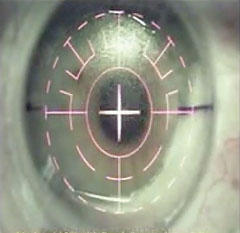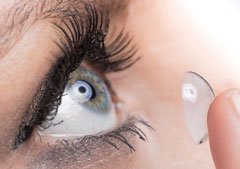LASIK Trumps CL Wear, Patients Report
Trading in contact lenses for LASIK makes patients happier with their vision years after the procedure.By Rebecca Hepp, Senior Associate Editor
A recent study published in the August issue of Ophthalmology found that contact lens wearers who chose to have LASIK were more satisfied with their vision compared with patients who continued with contact lens wear—and their satisfaction increased two and even three years post-procedure.
 |
| Patient self-reported data suggests LASIK provides better vision long-term compared with contact lens wear. |
Using follow-up surveys, the study found contact lens satisfaction declined with time, as 63% of patients initially expressed strong satisfaction with contact lens wear at the beginning of the study, and only 54% expressed the same sentiment by year three.
“This study shows that the control arm of contact lens wearers became less satisfied with their contacts over time, which makes it even more important for us to ask how their current vision correction affects their quality of life,” says Walter O. Whitley, OD, of Virginia Eye Consultants. “It reinforces the importance of optometrists staying involved in educating patients on all refractive treatment options available, including LASIK.”
LASIK patients in the study consistently expressed strong satisfaction: 88% of former contact lens users and 77% of former glasses wearers reported being strongly satisfied with LASIK at year three, which was consistent with responses at years one and two.
“With the efficacy, safety and patient satisfaction rates at an all-time high, LASIK surgery will continue to be a popular refractive option,” Dr. Whitley says. “Patients need to know what we do, and we need to proactively educate our patients that LASIK is a great option for many. Just like we do for vision and medical eye care, we need to advertise and market our refractive surgery services because if we don’t, patients will bypass our practices and go straight to the LASIK center. Optometry needs to be their source of information.”
| Price MO, Price DA, Bucci FA Jr, et al. Three-year longitudinal survey comparing visual satisfaction with LASIK and contact lenses. Ophthalmology. 2016;123(8):1659-66. |
Overnight IOP Monitoring Reveals OSAS, Glaucoma Link
A new study found an unexpected correlation between obstructive sleep apnea syndrome (OSAS) and glaucoma using a contact lens sensor (CLS) to monitored intraocular pressure (IOP) changes when patients stopped breathing during sleep.
The prospective cohort study involved seven OSAS patients with no ocular disease other than mild cataracts. The subjects underwent continuous, CLS-based IOP monitoring with overnight polysomnography. Nocturnal IOP records were categorized into apnea IOP and nonapnea IOP, and researchers statistically analyzed the differences between IOP levels in these two distinct phases. They concluded that, in patients with OSAS, obstructive apnea led to an immediate IOP decline during nocturnal sleep.
Hypoxic effects were also observed with breathing cessation, causing blood oxygen levels to drop and possibly triggering optic nerve damage. “What’s interesting in this study is that, as IOP was measured continuously throughout the night, they found IOP actually decreased during apnea episodes,” says James Fanelli, OD. “The authors postulate that this IOP reduction is due to decreased intrathoracic pressure that occurs during episodes of non-breathing. At the end of the day, though, during episodes of apnea, O2 levels are decreased, leading to a hypoxic situation, which in turn manifests as the basis of a variety of cardiovascular diseases associated with OSAS. This hypoxic situation, in turn, also affects perfusion and oxygenation of the optic nerve.”
Optic nerve damage resulting from hypoxia can occur without a spike in eye pressure—a finding that could clarify the specific nature of glaucoma with normal eye pressure levels. “We also need to keep in mind that other studies have indicated that IOP tends to increase during nighttime sleep and blood pressure tends to decrease at this same time, further compromising perfusion to the optic nerve,” Dr. Fanelli says. “Compounding the issue more is the topic of translaminar pressure gradients. During episodes of sleep apnea, intracranial pressure increases as well, and this may have some adverse effects on perfusion to the optic nerve head.”
The study calls for more research on IOP-independent etiology, such as episodic hypoxia, that could potentially link OSAS and glaucoma.
|
Shinmei Y, Nitta T, Saito H, et al. Continuous intraocular pressure monitoring during nocturnal sleep in patients with obstructive sleep apnea syndrome. Invest Ophthalmol Vis Sci. 2016;57(6):2824-30. |
1-800 Contacts in the Hot Seat
The online retailer of contact lenses is under fire again, this time from the Federal Trade Commission (FTC). The FTC recently sued 1-800 Contacts, stating the company unlawfully maintains anticompetitive agreements with its rivals that suppress competition in online search advertising. It also restricts truthful and nonmisleading advertising, leading to some consumers paying higher prices for contact lenses, the FTC said in a press release.1
 |
The FTC’s administrative complaint, issued August 8, alleges 1-800 Contacts entered into bidding agreements with at least 14 competing online contact lens retailers. The agreements effectively eliminate competition to place advertisements on search results pages. The FTC claims they hamper price competition in internet search auctions and constitute an unfair method of competition in violation of federal law.1
The 1-800 Contacts agreements were derived from lawsuits the company threatened or brought against competitors for trademark infringement. The company sought to stop computer users from seeing rival ads when using the term 1-800 Contacts.1 The FTC’s complaint claims these agreements are overly broad and don’t safeguard trademark interest.
“The FTC lawsuit against 1-800 Contacts sheds light on their questionable business ethics,” says Justin Bazan, OD, of Park Slope Eye in Brooklyn, NY. “For me, it serves as a reminder that 1-800 Contacts puts their focus on profits. While this lawsuit probably will not impact optometrists in any noticeable way, I do hope it can be used as a point of education for our patients.”
While the complaint brings the wrongdoing to light, optometrists will have to wait until April 2017 before the hearing, during which 1-800 Contacts is invited to “show cause why an order should not be entered requiring [them] to cease and desist from the violations of law charged in the complaint.”2
|
1. The Federal Trade Commission. FTC Sues 1-800 Contacts, Charging that It Harms Competition in Online Search Advertising Auctions and Restricts Truthful Advertising to Consumers. August 8, 2016. 2. The Federal Trade Commission. Complaint, In the Matter of 1-800 Contacts Inc., a corporation. August 8, 2016. Available at www.ftc.gov/system/files/documents/cases/160808_1800contactspt3cmpt.pdf. Accessed August 8, 2016. |
Beware of the Burn: Young Children at Highest Risk
One- and two-year-old children are at the highest risk for chemical eye burns, new research suggests. Despite commonly held beliefs that working-age adults were most at risk for chemical eye burns, this study is the first to show toddlers to be at highest risk. These findings point up the need for public education regarding avoidable and serious eye injury.
Factories and other businesses employing the use of chemicals have safety precautions in place, but such measures are not necessarily at the forefront in homes where improperly stored household cleaners and other chemicals put young children at risk. Because chemical burns continue to damage the eye even after contact, this type of eye injury potentially results in irreparable damage to internal structures.
Researchers analyzed four years of data from the Nationwide Emergency Department Sample and found that, while 24-year-olds were at highest risk among adults, one-year-olds were twice as likely to suffer eye burns. The risk drops off significantly once children were old enough to understand the dangers associated with household products.
The most common of these injuries, according to the researchers, results from alkaline agents, rather than from acids. Further, burns stemming from alkaline agents tend to be more dangerous because these agents continue to cause injury the longer they stay on the eye. Reducing these injuries in young people, according to researchers, is as simple as keeping household cleaners and other chemicals out of reach.
|
Haring RS, Sheffield ID, Channa R. Epidemiologic trends of chemical ocular burns in the United States. JAMA Ophthalmol. 2016 Aug 4. [Epub]. |
In the news
A handheld device created by engineers and physicians at Duke University has allowed them to perform scanning laser ophthalmoscopy and optical coherence tomography of the parafoveal photoreceptor structure in infants and children without the need for adaptive optics, according to a study published in Nature Photonics. The device, which weighs only 94g, could eventually give a much better picture of how the retina matures with age.
A recent systematic review, published by The Cochrane Library, found that treating simple corneal abrasions with a patch may not improve healing or reduce pain. The review, which included 12 trials and a total of 1,080 participants, found patients receiving a patch may be less likely to have a healed corneal abrasion after 24 hours compared with those not receiving a patch. Further research should focus on better quality trials and examining the effectiveness of patching for large abrasions, the authors conclude.
Allergan recently announced it will acquire ForSight Vision5, a biotechnology company that has developed a peri-ocular ring designed for extended drug delivery. The preservative-free, noninvasive ring rests on the surface of the eye and releases bimatoprost over multiple months to lower elevated IOP in glaucoma and ocular hypertensive patients. The first randomized, controlled Phase 2 study comparing the ring to twice-daily timolol drops demonstrated that one administration of the ring provided sustained IOP reduction for six months with a reduction of 4mm Hg to 6mm Hg at 12 weeks.
